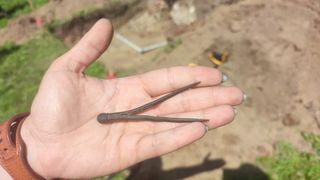
The sun might've just had a record-breaking number of visible sunspots
On Aug. 8, NASA scientists may have spotted a record number of sunspots when hundreds of individual spots were estimated to occur within 24 hours.

On Aug. 8, NASA scientists may have spotted a record number of sunspots when hundreds of individual spots were estimated to occur within 24 hours.

A metal detectorist found more than a half dozen pieces of silver jewelry while exploring farmland in Denmark.

The 500-year-old compass is a two-pronged metal device that scientists used for precise measurements in cartography, geometry and astronomy.

A small study suggests that people in their 40s and 60s undergo sizable physiological changes that may be connected to age-related illnesses.

Astronomers have long predicted that a collision between our galaxy and nearby Andromeda could be inevitable, but new calculations suggest this may be an over exaggeration.

Scientists have transmitted quantum data and conventional internet data through the same fiber-optic channel for the first time.

The large stone table is considered one of the most recognizable Neolithic monuments in England.

Using fossil evidence and genetic dating, geneticists and paleontologists have backed strikingly different candidates for the world's first animal.

The year's first supermoon is also the third full moon in a summer that includes four, making it a 'blue supermoon'. Here's how to see August's full Sturgeon Moon rise.

Book excerpt "If it's taken us 18 years just to get ready to do the first people in orbit, we've got to improve our rate of innovation."

Scientists are making mammary gland organoids with 3D milk ducts that could shed light on lactation and breast cancer development.

This is the first time that wrecks from the almost-overlooked conflict in WWII have been studied scientifically.

A new image of the Serpens Nebula captured by the James Webb Space Telescope shows that when clouds collapse to form stars, all of those stars spin in the same direction.

When did humans first roast food over a fire? Archaeology and biology can shed light on this mystery.


The smallest species of anteater grows to just 14 inches, including its tail — but it packs a hefty punch when threatened.

In the search for less energy-hungry artificial intelligence, some scientists are exploring living computers.

The moon's glow meets a stunning aurora in a new astronaut image taken from space.

When it comes to love, the adage is that opposites attract. But does that really hold?